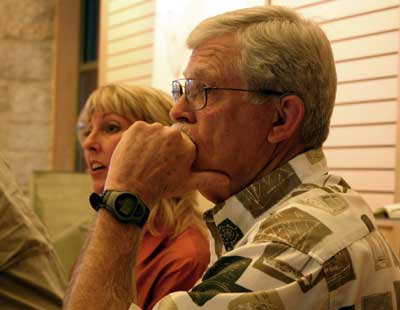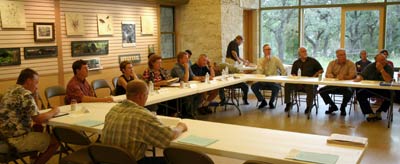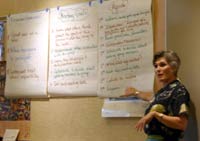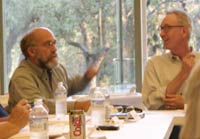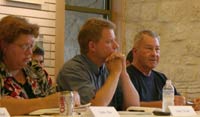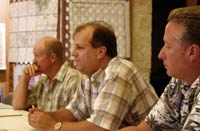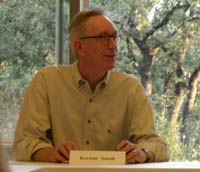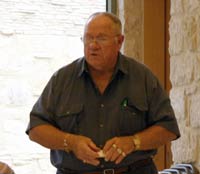MEETING
# 12
This
report came from Damian Priour:
It
was decided that we would list the things most important
to us
that did not make the cut last time. We would take these issues
to
the authorities that could most help us get them into reality.....
Dark Skies, Scenic Corridors, Open Space and one other
I can't
recall. Tonight we discussed Dark Skies and will be getting "dark
sky
ordinances" from existing sites so we don't have to reinvent
the
wheel. We want to take something tangible to the authorities
so they
will have something to work with. Next time we will finish
dark sky
discussion then move on to scenic corridors and so on. We want
to
push so that we can contact officials with our desires for
this community as soon as possible. It was
a
good meeting because we are over the hump as far as the "process" goes
and can focus on what we want and try to get it done. We'll see.
MEETING
# 11
December
1st
was the last officially facilitated meeting. Doc Juli and
company are now no longer being paid by LCRA to run the meetings.
It was held at the usual location, Westcave Preserve, and
this
time,
instead af the normal cookies and fruit, LCRA's Fred Crawford
brought a celebratory cake.
First
was a presentation (which I missed) by Mike Murphy, of the
photos he had taken to be included with the group's proposal
to
the LCRA. After this, the group resumed trying to hammer
out some language, upon which they all could agree, to present
at the December 7th LCRA Board meeting.
Regarding
modification of the standard LCRA water contract, Keenan
Smith suggested saying "anywhere the LCRA extends
service must abide by the NPS (non-point-source pollution
regulations)." When Bob Ayres mentioned that LCRA has no
jurisdiction in Hays County, Keenan ammended the wording
to "abide by the most stringent ordinance around". This seemingly
simple and reasonable proposal touched off a lengthy and
nit-picky discussion (so what else is new?). After a while,
Smitty said to Rebecca Hudson "What you have agreed to should
be a floor in all new contracts." In other words, he was
saying that her promise of 15% impervious cover should be
the maximum impervious cover allowed in any new development
with LCRA-supplied water. Rebecca replied "I can't sit here
and just represent myself so I think we should go for 20%."
Smitty then said "I don't want to get into your business
but that would put other developers at a competitive advantage."
Bob, seeking a consensus-friendly solution suggested that
they "leave this the way it is." (Ha!) Keenan again layed
out the "Everywhere pipe goes should be covered (by the NPS
ordinance)" statement. Rebecca said that was "not enough".
It should, she said "include all areas in the basin". Smitty
chimed in that it should "include all tributaries." And so
on...
Eventually,
Keenan, showing his frustration, said "We should be synthesizing
this into a broad and powerful message and here we are arguing
about 15 or 20%." Karen Hadden reinforced that: "We need
to look at the big picture." Smitty then made a bold proposal.
He said how about a "powerful statement - the (water) quality
should be no worse after development than before." In other
words, non-degradation. Rebecca would have no part of that.
She said "I'd rather stick with Fish (Fish and Wildlife guidelines)
because of the difficulty in establishing a baseline." (A
typical, self-serving developer's argument.) Karen then
asked Rebecca "Do you agree with this conceptually?" Rebecca
replied "The only way to keep it unchanged is to put up a
fence and not let anybody live there." Linda Lowenthal opined
"Somehow they can calculate that you can degrade a creek
30%. Why not go for better?" Phil Terrell wondered
"Since Lake Travis is already the cleanest (lake) in the
Colorado (River basin), what should be done?" Others
jumped on that with "Protect it from new development."
Keenan
then summed up the LCRA's dilema: "They don't have the authority
to carry out their mission. By legislative mandate, the LCRA
is not in the land-use business but, if you provide utilities,
you are in the land-use business. Every time they have stepped
out into land-use they've had their hand slapped by the legislature."
Smitty offered "the most powerful thing we can send is reccomendations
regarding the contract."
Tom
Kemler turned the discussion to the issue of whether the
group had a spokesman. Keenan, who had been nominated for
the job at the previous meeting (when he was absent) said
"I'd be honored to be the ambassador of the group if we can
get to some powerful messages." Karen offered an alternative:
"Maybe if Keenan can't buy in Bob would do it?" Keenan, frustrated
over a lack of a unified and powerful message, responded
"What do you expect anybody to do, just get up and start
talking?" And again the discussion returned to refining the
language regarding the contract. After some more on that
and a brief side trip into some other, easy to agree upon
points, Keenan again expressed his fears: "I want to be sure
if I'm going to be your ambassador that I can truly represent
you." Bob assured him that there was "a high level of confidence
in this room that you will do an elegant job." And so Keenan
agreed to stand up for the group before the LCRA board. A
committee was formed to help Keenan with his presentation.
The
discussion then turned to a plan for the group's continuation
after the facilitators are no longer being paid to facilitate.
Tom expressed his fear that, since the facilitators have
been "training wheels", he wondered "What happens when we
take them off?" Linda Ellis said "We need to go on without
the wheels." To this, there was general agreement. Bob suggested
that what had been begun could be "the nucleus of a Hamilton
Pool Road neighborhood association." This idea was heartily
accepted.
Before
adjournment, they went around the table with each person
expressing their feelings about what this process had meant
to them. This, to me, was positively sickening. Here was
a group that had spent week after week in agonizing disagreement,
coming to consensus on actually very few substantive suggestions,
now proclaiming their love for the group and the consensus
process. Yeccchhh! Even people who had complained mightily
time and again about the lack of meaningful accomplishment
seemed to forget all that in their brief, delusional moments
of sentimentality. Doc Juli, of course, offered her final,
emotional praise of all the members and her pride in what
they all had accomplished. 'Scuze me for being my normal
cynical self but I just didn't see it. Oh well, it was interesting
and there was some entertainment in there with the general
sense of frustration I felt pretty much throughout the process.
Good night, Gracie.
Epilogue:
Considering his constraints, Keenan did a decent job of presenting
the group's case to the LCRA board. Much more powerful though
were Christy Muse's and Gene Lowenthal's presentations, full
of
strong facts and passion. It all mattered naught, since the
board's minds were made up before word one was spoken and
they approved the unthinkable - the pipeline leading to the
destruction of our peace, tranquility and rural way of life.
Hello suburbia.
MEETING
# 10
They
held this meeting, November 18th, at the Bee Cave Municipal
Complex. I was flooded in and couldn't bring myself to schlep
the
long
way
around (Fall Creek Road). This would have taken almost an
hour each way for me instead of the 3 minutes it normally
takes to just walk across the road to Westcave
Preserve. Anyway, no report on that meeting.
MEETING
# 9
The
November 11th meeting began with a pre-meeting presentation
on conservation easements which I missed entirely, coming
in
in time for
the main meeting. This one was lightly attended, with a number
of people out sick or with other committments.
Juli
began with an announcement that she had received an email
from a small local landowner who is friends with a large
landowner who complained that Rebecca Hudson is the only
representative of "economic interests" in the group and wants
to make sure their point of view is considered.
Then
the discussion of "water strategies that have not been discussed"
began with the suggestion that LCRA should promote rainwater
harvesting by offering "affordable long-term loans to individuals
for installation of rainwater collection systems". Linda
Ellis kicked it off saying that the LCRA does not have loan
authority. LCRA guy Fred Crawford backed that up, saying
they are not allowed to make loans to individuals. Rick Schroeter
said he thought that that they might be able to since they
did make loans to commercial entities. Linda Ellis suggested
that the use of "rebates or discretionary funds"
to encourage
homeowners
to do rainwater
would be a conflict for them. She asked "why would they want
to do it and sell less water?" Phil Terrell added that they
probably wouldn't do it since they are primarily in the electricity
business. Becky Combs' take was that the main problem is
"no state standards for rainwater". She felt that the first
necessary step is to "go to the legislature and get state
standards adopted."
Tom
Kemler chimed in "I'm all for rainwater but this would be
DOA at the LCRA." And Rebecca Hudson felt that rainwater
systems would keep people from getting surface water because
of the "liabilities".
Bob
Ayres felt that the solution would be to make the recommendation
"general". He just wanted to "promote rainwater collection
in general". To this, Linda Ellis pointed out that "lake
water is rainwater." Keenan Smith responded that his water
(coming from a rainwater system) had "never hit the ground,
never sat in a lake", etc. And Linda Ellis then came back
supporting the idea of simply promoting the concept without
the incentives. Keenan said "I would have loved to have some
incentives besides knowing that I'm doing the right thing
for the environment and that my water is better than anyone
else here." (Go Keenan!)
Tom
and Linda E. opined that you can't get financing for rainwater
systems but Keenan responded that he had. Richard Grumbles
added that all you need is a letter from a water hauler saying
that you will be able to get water delivered should a drought
dry your cistern and the financing can happen.
Then
the conservation turned to the idea of LCRA purchasing "connecting
conservation easements". Phil said "I don't know how this
would be done but I love the length of the sentence." Keenan
asked "How cool would it be to connect up existing easements?"
Becky suggested that this could be done "along waterways"
but Keenan said "Don't limit it." He suggested that there
may be lots of other reasons for easements. Bob Ayres again
wanted to "make it general" and leave the LCRA out. He pointed
out that "They (LCRA) don't have to be the purchaser or holder
of easements. But Becky asked "Why not LCRA?" She pointed
out that others "might not have this in their mission." Keenan
built on this. said that there are lots of other entities
but "Let's try to change the culture of LCRA and expand their
mission."
At
this point, Tom,
directing his question to LCRA representative Fred Crawford
asked "How
much can
we
ask LCRA
to give? How
much
fat is
on that cow?" Fred responded "This is ratepayers'
money and
we take that seriously." He pointed out that LCRA
had spent $1 million on conservation this year. He said "We
don't have staff to oversee conservation easements." He
felt that perhaps they could expand to include the purchase
and management of easements but that it would be a board
decision because "It would be new ground for us." Tom theorized
that such action might "cause a ratepayer rebellion."
Phil
said that he didn't "feel comfortable with restricting this
to the LCRA who are not in the land management business."
Richard expressed his ongoing fear about government ownership
of land, saying that he was "concerned
that LCRA might condemn land to connect easements." He pointed to the Barton
Creek Greenbelt where "you could be arrested for trespassing."
He reiterated that his concern was about a "government entity"
owning land and restricting access. To this, Becky, a lawyer
who specializes in conservation easements, replied that "the
government can't condemn land for conservation easements."
She said it has to be voluntary.
Bob
Ayres now suggested adding the phrase "by willing sellers
or donors" to eliminate confusion about condemnation. This
was accepted by the group.
Tom,
now trying a slightly different variation suggested that
this sort of thing should possibly not be sent to LCRA because
"what we're talking about is not on their plate." He feared
that they might just respond that conservation easements
are "not my department." Rebecca Hudson jumped in then to
say that she thought "this might be an area that the LCRA
would be willing to go into." Tom replied "I'm speaking much
more broadly here than just this point." At this point I
said to myself "huh?"
Linda
Ellis then said "We've been given the opportunity to be visionary."
She colorfully continued "Let's don't chop our feet off before
we step out on the visionary path." Keenan supported this,
saying "Many of the things we are envisioning are overarching.
I would like to see the LCRA expand its role as conservers
of land - the water line comes, something gets conserved."
Richard chimed in "Joe Beal is giving us time to create a
vision, not just what the LCRA can do." He continued "LCRA
is powerful and people listen when they talk." Linda Ellis
embellished this saying "Conservation is unavoidably part
of their mandate."
The
rarely heard from Linda Lowenthal pointed out that "According
to Fred (Crawford) they (LCRA) would like actions they can
take as well as vision." Then she proposed that the group
move on to "the hard part - regulations." Keenan said "I
suggest #8" (The draft of this item reads: "The LCRA
should develop and enforce stricter Non Point Source pollution
ordinances for the watershed areas of Travis County. The
LCRA should encourage the goals of a community's majority
by limiting the LCRA's presence and influence to what the
Community's majority wants.")
Linda
Ellis said she could agree if this were "broad and not on
an impossible timeline." Bob added "Make it refer to other
regulatory agencies as well."
My
notes get a little confused here but I think the discussion
shifted to article #15, which
says "LCRA delays providing water to the HPR area until
there are qualified and trained personnel with adequate time
and
authority to review development designs to insure [later
changed to 'ensure"] that they actually comply with all
requisite standards, (including, in the case of the developments
currently
seeking water, the U.S. Fish and Wildlife Service Guidelines),
and to monitor these developments as they are built, and
to effectively enforce any violations."
Linda
Ellis said that she did not want "not until", which she felt
was "negative" wording because it implies "don't come until..."
She clearly wants the water to come and said she would prefer
wording like "Bring the water with full intention and capability
of enforcing stricter NPS guidelines." Richard Grumbles said
"I'm concerned that with the CCN (Certificate of Convenience
and Necessity) they'd have to provide water." He feared that
developers could say "I'm operating on less strict rules."
Karen
Hadden now joined the discussion saying "There needs
to be an agreement in place if water is supplied."
ED.
NOTE: At this point, the minutia of the discussion conspired
with my carpel tunnel writing hand to completely throw my
train off the tracks. I'm not sure what happened next but
I did pick up a couple of quotes:
Tom complained about the wording of the article, expressing
the feeling that he "objects to adverbs."
Keenan
responded
"Is
there not
a time and
place
for circumlocuitous behaviors?" In the end, they did eliminate
an adverb or two but kept one, substituting "actively enforce
any violations" for "effectively enforce any violations."
Rebecca
expressed her fear that "only new subdivisions would be
subject to the restrictions." Fred Crawford offered his opinion
that, according to the TCEQ (Texas Commission on Environmental
Quality), with the CCN, LCRA could not "withhold service
or impose unreasonable restrictions." He suggested that NPS
regulations might be expanded into uncovered areas by saying
"Travis County statutory district" rather than just in the
LCRA's watershed.
Keenan
then asked "How can you expand the service area and not extend
enforcement?" Fred responded "Hang your hat on water quality.
If water quality rules are in place, then whoever gets the
CCN would have to enforce compliance." Rebecca Hudson had
the last word at this meeting, saying that the good thing
about the LCRA is "they are willing
to
impose restrictions." [Of course, with the CCN, they
may not be able to. There, now I've had the last word.]
MEETING
# 8
This
meeting, held on November 3rd, was another doosey. First
up for a pre-meeting presentation was Michael Barrett, Associate
Director of the Center for Research in Water Issues at UT.
He helped write the Fish & Wildlife endangered species
protection guidelines and works as a consultant to F&W who
do not have enough staff to review everything. When a developer
wants to get water from LCRA, the
LCRA will often send him the plans to check F&W compliance
before passing on the water contract.
He
told the group that the Fish & Wildlife guidelines were
basically a "softer version of SOS", meaning, I guess, that
they were actually less stringent than the City of Austin
SOS Ordinance. He said that Austin is in the top of the range
countrywide in terms of non-point-source controls. Apparently,
across the USA there are very few areas that provide such
controls. The city is in with an elite group including Seattle,
and the States of Wisconsin and Maryland, who try to limit
NPS pollution. The limits in these places though, generally
call for only an 80% reduction in the amount of pollutants
allowed in the run-off. I suppose this means that
they allow run-off to contain 20% pollution from every development?
As
to whether it is possible to keep the environment pristine
with
development,
Michael
opined
that
you can make
plans and tweak all you want but without sufficient inspection
and enforcement mechanisms it is just not possible. He said
that the LCRA is the only possible enforcement agency but
they don't like the enforcer position - being the "water
quality police". He said that their Republican-appointed
conservative
board does not want them in that role. Mr. Barrett did feel
though, that "it would be nice if someone went out and
checked."
When questioned about the effectiveness of Fish & Wildlife
guidelines, he gave them an "8 out of 10".
Damian
Priour asked if any people had brought plans to him from
the Hamilton Pool Road area to see if they met Fish & Wildlife
guidelines. Michael's answer was "no". Damian followed
up asking again (just to be sure) and again Michael said "not
that I can remember." I guess that, as far as Michael
Barrett knows anyway, no developer out here can be sure that
they are actually meeting
those guidelines.
The
second pre-meeting presenter was Don Nyland of the Texas
Department of Transportation. He jumped right into answering
questions. He said that a "detached" hike and bike trail
was unlikely because of the maintenance it would require.
What TxDOT would rather do, he said, is "build 8-10' shoulders"
which would make bicycling much safer. Hike and bike trails,
he said, are generally "circular" and parks are a better
environment for them - not done within the department's highway
projects. The department does sometimes work with counties
and help with funding if the counties want to build trails.
He also said that the legalities of bike lanes along the
roads are prohibitive, since driveways and the like crossing
those trails make them very difficult.
When
asked what improvements, if any, are planned for our road,
he responded that "nothing for Hamilton Pool Road is budgeted
right now." There is, he said, a 3-5 year budgeting process
so it is unlikely that any improvements will be funded by
the state in the near term. He did allow though, that if
developers want to absorb the cost of road improvements,
the process can be sped up considerably (but rarely in less
than a 3-4 month time frame). Projects he pointed to where
that is happening are the Galleria on 71 and a turn lane
on HPR by Cueva (which is being funded by the City of Bee
Cave).
Of
course, there is always the death factor. Don pointed out
that "the more people who die (along a particular stretch
of road), the more likely something will get funded."
The
difficulties of improving our road include the fact that
lots of additional right of way would have to be purchased.
For a 4 lane highway with a turn lane (I don't know about
you but that is just what I've been dreaming about), they
need about 150' of right of way. In addition, such construction
plans must be passed by NEPA (the National Environmental
Policy something or other) as well as the TCEQ (Texas Commission
on Environmental Quality) to make sure they would cause no
problems with endangered species, etc. Hurdles - good.
When
asked if the DOT might straighten, widen and raise the Pedernales
River crossing, Don said "no, that's county road." Apparently,
the county did once ask DOT about building a new bridge over
the river but it was determined that it could cost $10-25
million and there would be no benefit because there is no
problem with the low water crossing and there is really no
need at present. This is a really good thing from my perspective
since a huge
bridge,
with traffic whizzing by within a stone's throw of our house,
would certainly have a deleterious effect on our little piece
of paradise. Again though, if a deep-pockets developer
wanted to put up the dough, the department might be willing
to reopen
the discussion.
On
the subject of road abuse caused by development, Mr. Nyland
said that "there is no law requiring developers to pay" for
problems they create.
Finally,
when asked about the possibility of a scenic corridor being
established here, Don said that anything above the cost of
the roadway itself would have to be a county expense. He
pointed out that they would have to buy extra right of way
because they can't require landowners to maintain a scenic
easement by not developing part of their land.
Then
the actual meeting began and oh, what a meeting it was. It
began with a discussion of reaching a consensus on how to
achieve clean water. Tom Kemler started the ball rolling
with a complaint that the group's established guidelines
for consensus had not been followed at the previous meeting.
Linda Ellis agreed, noting that the process had been hung
up by just one person. Juli then jumped in and made a heart-wrenching
apology for her behavior at that last meeting. She said how
bad she felt over "the pain and frustration" caused by that
abbreviated process. She vowed to follow the guidelines from
then on. No alterations, however, would be made to the memo
already sent to the LCRA board, which contained only 5 totally
agreed-upon points.
Bob
ayres then seemed to defend Juli's actions, saying that they
had been asked to propose only points that they assumed the
group already agreed on and that people hadn't followed that
directive. He said that they had, in fact, made points that
they knew wouldn't have consensus.
Karen
Hadden then made her first of several efforts to get the
rules changed to allow for an occasional "straw poll" to
determine the general feelings of the group in the absence
of absolute consensus. Smitty followed up saying "I'm not
sure consensus will be the end result of this group." He
asked "How do we report and characterize our work without
consensus?"
Phil
Terrell said "We are here to create bubbles." He felt that
details should be left for someone else to work out but that
this group should focus on "generalities that we can reach
consensus on." Juli siezed the opportunity to point out that
"this group is not constituted to vote." She said it has
an unbalanced composition and that if it were to be a voting
group, there would be more developer representation. To that
I say bunk. The group has a fair representation of the composition
of the road's population. In my opinion, if anything, it
is unfairly weighted on the side of development.
Then
Tom said that it
is "not positive to say 'I want my point of view represented
even if there isn't consensus'" since "we all agreed to consensus."
Becky
Combs, in response to Phil's statement, opined that the group's
mission included working out details.
Tom
then refined his earlier complaint, saying "it all happened
so fast, I didn't get a chance to get my hand up." This,
to me, sounded like he was saying he would have objected
to more points at the previous meeting had Juli not rejected
points as soon as she saw a single hand in opposition.
Karen,
again arguing for voting when large numbers of group members
seemed to agree, expressed her concern that "points
of view are being thrown out because
of a few
dissenters." To this, Judy, the other facilitator,
argued for consensus by saying "United, not divided
makes us more influential." [Sounds downright presidential
to me.]
Becky
chimed in that her interpretation of following the guidelines
is recording various points of view in the absence of consensus.
She wanted to further clarify the tenor of the group by recording
the numbers of people in favor of a particular idea. Juli
responded that they would flat out "not use numbers (of votes)".
Bob
Ayres then said "What interests me is finding where a diverse
group can find common interests and agreement." Smitty replied
that "it would be a lost opportunity" if the findings of
the group were "too global". He said that the LCRA board
doesn't have time to consider all the details, that they
"want them from us." By way of explanation of the kind of
details he was referring to, Smitty pointed out that he had
recently spent 6 hours trying to match up group
goals
with
existing
laws. Linda
Ellis siezed on that to suggest that Smitty be used as a
resource to do the detail work. Then she seemed to negate
that by saying something about not being able to agree to
the detail that Smitty derived from his 6 hours of work since
she hadn't done the research herself.
Damian,
returning to the "why not vote?" theme, asked if the reporting
could not at least use percentages. He asked why would you
want to give a false perspective by submitting points of
view without supporting numbers. Juli responded that numbers
are for voting but "not honest in a group set up for consensus".
Rebecca
Hudson said that she wanted the group to "stop taking polls
and talk about issues." She also wanted to "stop talking
about process". [If I were allowed to speak, I would have
seconded that one. But wait, there is no seconding in the
consensus process.]
Then
Randy Rice offered his opinion that "the process is so overly
cleansed that it can't reflect what this community thinks."
[I'd second that one too.]
Rebecca
said she felt that "any descriptive words" such as "many,
few, etc." sounds like voting.
And,
with Juli's assurance that she would try to accurately record
the various opinions, an actual (if brief) discussion of
the issues at hand began. First, Keenan Smith suggested a
rewording of one of the draft actions to read "Encourage
conveyance
of conservation easements by educating landowners about the
benefits." Tom, never one to hold back on a tweak, asked
"Why specify how? Why not just leave it at "Encourage..."
Smitty allowed that "details provide tools to accomplish"
the group's goals. Tom then argued that the 10 commandments
were much more powerful than any federal law because of the
detailed nature of laws vs. the simplicity of the 10 commandments.
He said "More detail is more potential for exposing weaknesses."
Becky again stressed the value of details, saying "we need
to provide a roadmap."
Keenan,
probably hoping to change the subject, mentioned that he
thought the LCRA should set aside a portion of their revenues
to acquire conservation easements. To this, Robert Potts
kicked in that for the Highway 290 pipeline, they had hook-up
fees to go into conservation. He thought that maybe that
could be done here, to which Keenan added that the Land Trust
is always looking for funding.
Karen
suggested that a compromise might be to use the general point,
then elucidate with the specific suggested ideas that were
being kicked around the table. Devon Humphrey expanded on
that with the idea of an executive summary, followed by expanded
detail. LCRA man-on-the-scene Fred Crawford was asked his
opinion and he responded that he thought the group could
put in as much detail as they wanted. To this, Tom reiterated
that he was "still not comfortable with detail."
Linda
Ellis said that "telling the LCRA to put money into conservation
is preaching to the choir. That is their mandate".
Bob
Ayres' presentation approach would be to "put in what we
have consensus on but bold out the major points" so they
are easily seen. Rick Schroeter, with his characteristic
to-the-pointness said "Be brief but be specific." Phil picked
up on the executive summary idea and suggested "a two page
summary" with a book of supporting documents.
At
this point, the group had achieved consensus on two ideas
as details for the general point of encouraging conservation
easements and I, for one, was exhausted. But it wasn't to
end just yet. Linda Ellis got last licks saying that she
didn't want the tap fee to be targeted for use for easements.
She said she doesn't want to "pressure them (LCRA) to increase
their pricing structure."
And
that was it. The three remaining meetings are November 11th,
18th and December 1st. Let's see what happens at the next
one. Stay tuned.
MEETING
# 7
The
regular (7:00 start time) part of this meeting was preceded
by a presentation by Randy Goss and others from the LCRA
on their monstrosity of a master plan for piping western
Travis County. Randy noted that there are currently a total
of about 3000 LUEs, which stands for Living Unit Equivalents
(but means individual water hookups) on their system. Could
they have come up with a more obscure term? How about "taps"
guys? Right now, Randy told the group, there are requests
for an additional 6,000 LUEs over the next 15 years. They
project
that by 2035, that number will expand to 43,000, serving
50-60% of the area's total population.
He
explained that subdivisions such as Rebecca Hudson's Rocky
Creek Ranch require on-site sewage treatment because, since
the '80s, there has been a ban on discharging effluent into
the lake for developments less than 10 miles away. I don't
get that but I think it is what he said.
Randy
went on to say that the LCRA board had instructed the staff
to see about applying to the Texas Commission on Environmental
Quality (TCEQ) for a Certificate of Convenience and Necessity
(CCN) to provide water services
for the region.
The CCN,
essentially, gives the holder a monopoly for providing such
services in the covered area. It also requires the holder
to provide service to anyone in the area who is willing to
pay the established price. Randy assured us that they were
not going to "build it (the pipeline) and hope they come."
I think Randy is sincere and hope he is right but, given
Manager Joe Beal's dreams of a water empire, I suspect that
there will be pressure to do just that. Smitty asked if the
CCN would include wastewater services. The answer was no.
The
CCN, Randy said, provides some leverage to put restrictions
on development since ther is no competition, therefore no
alternatives. John Hatchett pointed out that
the CCN would, in fact, take away potential for enforcement
power by requiring service when now (without the CCN) it
could be denied if certain requirements are not met by the
developers.
In
the late-breaking news category, we have recently learned
that Randy Goss has resigned from the LCRA. It is not clear
exactly when that happened but some say it was on Wednesday,
the day he came to make the presentation.
After
a pretty lengthy discussion of whether or not to allow the
LCRA presentation portion of the evening to extend beyond
it's scheduled completion time, it was decided to let it
go another 20 minutes, after which the actual group meeting
began.
The
first business of the meeting was to go through the list
of 26 bullet points that had been sent in by the members.
Those items that were supported by concensus were to be presented
to the LCRA board in the form of a progress report memo.
The points, as compiled by facilitator Juli, were:
"Compilation
of All the Suggested Bullets for Board Memo 1
Comments on Values
a. We value the natural community to which we belong, and the human community
to which we belong.
b. We are working to insure that as we work to protect our natural
community, we address the needs of our human community (safety,
transportation, utility services, education, recreation).
Comments on Process
c. We are working to insure that poorly planned growth does not destroy the
characteristics of the human and natural communities which make the Hamilton
Pool Road Corridor a desirable place to live.
d. We have been introduced to innovative models of regional
planning that hold great promise, but that cannot be completed
in such an abbreviated time frame.
e. We are inviting experts to report to us on our various areas
of concern or interest. Example: We realize traffic safety must
not be sacrificed for a scenic corridor; the two should complement
each other. Efforts are, therefore, planned to attain information
from TxDOT on this subject.
f. Recommend that
the Randall Arendt "Growing Greener" concept
of Subdivision planning be used to conserve natural areas.
Comments on Timing
g. It is important that the 3 stakeholder groups finish their work before any
approval of a waterline down Hamilton Pool Road is made by LCRA.
h. The desire to allow
the several stakeholders’ committees
that have formed to be able to complete their work (within the
next 6 months) before there is approval of any contract to extend
the waterline down HPR.
i. A consensus that the three stakeholders committees should
finish their work (within six months) and LCRA should LISTEN
to the results BEFORE approving any contracts for water or wastewater
down HPR.
Comment on Waterline
j. Bringing surface water to Hamilton Pool Road will indeed make it more difficult
to achieve our stated vision for the future of our community.
Comments on Enforcement
k. There is a need to set into action a plan for enforcing our community’s
stated vision for the future of Hamilton Pool Road.
l. A need to have in place monitoring and enforcement entities
that can protect natural areas that might be impacted by development.
Comments on Density
m. High density residential and commercial development are not what this community
wants.
n. A consensus that large-scale high-density residential developments
are not compatible with the existing HPR community.
o. A consensus that high density, large-scale residential development
is not compatible with the existing HPR community and not compatible
with our future vision for the HPR area (scenic corridor, clear,
clean water, natural waterways, dark skies, natural open spaces,
and clean air).
Comments on Water
p. This is the last best chance for LCRA to protect the water and the wildlife
in the region.
q. Their existing raw water contract has a number of paragraphs
and appendixes that can and should be updated modified to assure
that the water quality is protected through stronger wastewater
control standards, run-off controls, non-point pollution source
controls and vegetation standards.. The contract can be modified
to assure that runoff controls are inspected regularly, after
torrential rains and maintained.
r. The right-of-way over any potential water line should be
made available for hike and bike trails and equestrian trails.
s. A consensus that LCRA should not begin a master water project
that will promote urban sprawl in this environmentally sensitive
area; there is/will be plenty of demand for water in areas east
of Austin that are not as delicate as the western Hill Country.
t. A consensus that LCRA should focus on enhancing the water
supply through use of rainwater systems and protecting the water
supply through effective implementation, monitoring and enforcement
of effective water quality controls in the HPR area.
u. A consensus that
from a fiduciary, financial and credibility standpoint, LCRA
should fix it’s operational problems,
for example Sunset Beach water system, before is moves further
into the water supply business.
Comments on Wildlife
v. Recommend that the TPWD "Private Lands and Habitat Program" be
used in the preservation and development of wildlife habitat in Subdivision
natural areas.
w. A consensus that LCRA should use its available funds to protect
water and wildlife through the purchase of conservation easements
in the HPR area.
Comment on Traffic Safety
x. Recommend that center turn lanes and additional law enforcement on HPR be
implemented.
Comments on Vegetation
y. A need to develop a strategy to utilize native plants, reduce water usage,
discourage St. Augustine lawns and landscaping that is out of character for
the region, and to discourage the use of pesticides, herbicides and fungicides
in the region.
Comments on Aesthetics and Dark Skies
z. A need for sign ordinances and requirements for downlighting."
These
points were brought before the group in rapid-fire
succession and the members were asked if anyone objected
to each as it came up. Of the 16 group members at the meeting,
13 or 14 (81%) were in total affirmative agreement about
just about every point. All of the points f - z (21 of the
26 points) were objected to (essentially vetoed) by Rebecca
Hudson (who,
by the way,
spent a good portion of her time at the meeting working crossword
puzzles). One or 2 other people disagreed with some of
those same points
(it
all went by
so fast that it was difficult to tell). In the end, they
were left with consensus on only 5, rather innocuous "motherhood
and apple pie" type
items.
But
here is where the railroad job happened. When members asked
for further discussion on the rejected points in an effort
to
achieve concensus, Juli put the kibosh on it with the declaration
that there was not enough time. This, it seems, is a violation
of the group's guidelines, which state:
"Use
of consensus.
The
Core Group will make decisions by consensus. Consensus
is defined as
each member freely agreeing to support an item. Group decisions will be
made only with the concurrence of all members represented at that meeting. If
consensus is reached, all attending members agree to support that decision publicly.
Failure to
reach consensus.
All members share responsibility for the process
and the decisions. When consensus is close
but someone disagrees, the member who disagrees must state the
reasons for their objection and give an idea for how their needs
and the needs of the group can be met. If the Core Group
cannot reach consensus on an item, the facilitators will record
the various opinions and interests of the group and note the
lack of consensus. Members retain their right to comment
positively or negatively about any item on which the group was
unable to agree."
No
discussion was allowed and no dissenting members were asked
to "state the
reasons for their objection and give an idea for how their needs
and the needs of the group can be met." Hmmmmm!
MEETING
# 6
While
floating in the river, I suddenly came to, remembered the
meeting and swam quickly back to my clothes. I ran up the
hill and
dashed
across
the road in time to catch the last part of Keenan Smith and
Devon Humphrey's impressive Powerpoint presentation on how
the conservation design concepts of Randall Arendt might
be used
in arriving
at a plan and preparing this group's final report. With computer
and projector, they showed a map of the area, then were able
to overlay such imagery
as creeks, properties and traffic patterns. Keenan made the
point that using Arendt's conservation development principles,
private development interests could be brought on board.
They could be shown how green building is what people want
and just good business.
Much
of the ensuing discussion was
centered
on how
the group would
proceed
-
whether to continue with the planning process already in
motion (Plan A) or to adopt the new process proposed by
Devon & Keenan (Plan B). In the end, it was Plan J that won.
It was decided to continue on the current path, while bringing
in outside consultant/presenters and using some of the visual
presentation capabilities that Keenan and Devon demonstrated.
Facilitator
Juli restated the 4 major areas of focus that the group
had agreed upon - water, clean air/dark skies (lumped together,
though I see no connection), open spaces and establishing
a scenic corridor. Several concerns were voiced about unincluded
issues. Rebecca Hudson asked if the group couldn't discuss
TxDOT (Department of Transportation), schools and emergency
services. Juli responded that these items could only be
included if others were dropped. Smitty Smith wanted strong
consideration to be given to wildlife. Becky Combs pointed
out that open
space includes wildlife. Rick Schroeter said his main concern
was traffic safety. Richard Grumbles added on to that the
very real possibility that these new proposed toll roads
could make Hamilton Pool Road a heavily trafficked bypass
route (as if I didn't have enough to worry about).
Juli
then asked that each group member state, in 60 seconds or
less, what "keeps them up at night" in the way of obstacles
to achieving their vision for the area. Here are their causes
for insomnia:
• Damian Priour said that, though he knows that most
in the group won't
agree, he feels
that the vision will only be achieved by "keeping people
away". He said "I don't buy into the idea that growth is
inevitable." Go Damian!
• Sandy Wood talked about the fact that Highways 620, 71 and
183
are "out of control", that they suffered
from a "snowball" effect and that he wants "to keep that
snowball from happening here."
• John Hatchett said his fear was "loss of community".
• Richard Grumbles worries about "wall to wall houses, four lanes of traffic,
being forced from the land by heavy regulations and losing private property rights
because people think land should be publicly owned."
• Devon Humphrey said he came out here knowing growth would happen. He
feels that "people want the water and worry about traffic and wildfire. To protect
the area he
wants
"land use and conservation planning".
• Keenan Smith is concerned about a "future vision". He worries about "the
inability of people who love the area to have a say" and he worries that there
is "no planning".
• Becky Combs worries about wildlife. She said that "dark skies and
subdivisions
don't go together". She also mentioned that so far, western Travis County has
avoided
the growth that is rampant in the rest of the Austin area (and, would like to
keep it that way).
• Rick Schroeter would like to see "road improvement for safety".
• Rebecca Hudson worries how to "raise enough money to buy property rights".
She feels that she is a conservation developer and would like to see others do
the same. [Note: According to Randall
Arendt's conservation development principles to which Rebecca claims to subscribe,
50% of the "developable" land should not be developed. This does not appear to
be the case with her Rocky Creek Ranch subdivision.] Rebecca also repeated
a variation on her "we're old timers" theme, saying something like "maybe you
(the
other
members of the group?) aren't here long enough to remember, but traffic and roads
are coming." [Yes Rebecca, in the near term, to a large extent thanks to you.]
• Phil Terrell's "number one dream is good, clean water. Number two is
wildlife." He doesn't want to see "a repeat of what's happening in Westlake."
• Tom Kemler feels that "we are fighting the wrong battle". He said that
"the LCRA is there to provide water" and wants to know "why are we dealing with
the LCRA?" His feeling is that we should be dealing with the Texas legislature.
He also said that Hamilton Pool Road is "a spoke on a wheel and the Austin end
is a lot different from out here (the western end)". He worries that there is
"no unifying vision for Hamilton Pool Road".
• Linda Ellis said that she has "worried about safety issues for 18 years".
She is sure that "growth will come, even if the (LCRA) water line does not come"
and she feels that growth without the water line would be the worst possible
situation.
• Linda Lowenthal said that "population will be fueled by large subdivisions".
These subdivisions will be populated with suburbanites, who "have different values".
This, she fears, will lead to "loss of community". [I second that emotion.]
• Smitty Smith said "no Ben White Blvd." He worries about "no enforcement,
not enough parkland and assuming wse come up with a vision, how do we sell it?"
[Amen.]
• Bob Ayres worries that it will be difficult to keep planning working
because "economic drivers are so intense". He also fears that "counties
don't have adequate enforcement and the LCRA doesn't have an appetite for land
use
planning."
• And finally (on his second time around) John Hatchett expressed his nightmare
- "apartments like those on Steiner Ranch will come with the water." [Thanks,
John. Now I can't sleep.]
Juli
then brought up the interesting news that she has been receiving
emails from an anonymous source, saying that there are large
landowners along the road whose points of view are not being
represented in the planning. The group's feeling seemed to
be that people had been offered opportunities to get involved
but, just to make sure all voices are heard, those who know
large
landowners
will speak with them and bring their concerns back to the
group.
Regarding
future expert speakers, Juli told the group that because
Fish and Wildlife is involved in a lawsuit, the person from
there that the group would like to have speak cannot come.
Sandy suggested that somewone from CAMPO be added to the
presentation from TXDOT.
Richard
Grumbles brought up the desire of landowners to see proper
restoration done in the aftermath of pipeline construction.
Linda Ellis suggested that they might not want restoration
done to the previous (unnatural) conditions.
Becky
Combs would like to get information from the school districts
regarding their plans and projections. And Rick Schroeter
would like the same sort of info from the local EMS providers.
Smitty
expressed the fear that the discussion was getting away from
the idea of a scenic corridor. Damian, who has researched
that concept, pointed out that it was the domain of the US
Parks Dept. and seemed to be a difficult row to hoe. Becky
told the group of a plan, put together about 5 years ago,
by a professor named Dr. Kimmel (she thought) for a scenic
corridor. The plan was, apparently, rejected. But Becky opined
that conditions may be different today and she would try
to find out more about that plan and bring it to the group.
The
meeting then adjourned but private discussions went on for
close to another hour and only ended when John Ahrns turned
out the lights and encouraged the stragglers to depart.
MEETING
# 5
Darn,
missed another one. I guess I'm not on the Doc Juli distribution
list anymore. In any case, I did hear a bit about the meeting.
When
asked, Fred Crawford, the LCRA observer at these meetings,
told the group
that he writes a report after each meeting and then passes
it along to someone else. That person synopsises the report
and passes it along to the board. Fred, apparently, never
gets to review how his report was edited so it is difficult
to know exactly what picture of the local planning process
the board is getting.
Mr.
Crawford also mentioned that the LCRA has no authority to
enforce their own non-point-source pollution
regulations with regard to the Hudson subdivision
because it is not in the Lake Travis watershed. It was also
mentioned that, unfortunately, the TCEQ (Texas Commission
on Environmental Quality) is 3 years behind in their inspections.
Again,
they broke down into small groups and presented to each other
pictures (which they had been asked to bring) representing
their visions for the future of the Hamilton Pool Road corridor.
Some brought photos of the beautious environs. Some brought
illustrations
of
where the road might be improved, where development might
best occur, etc. Rebecca Hudson brought
the plat of her subdivision as her suggestion for how the
area
might
look
in the future. Then, in order to demonstrate how conservation-minded
and what a low density developer she is, she brought a second
version of a plat of her land, showing a potential 1,900
lots. She told the group that she could have done what the
alternate plat shows instead of what she considers to be
low density - her subdivision with 468 homes, each lot with
60-80' of frontage.
MEETING # 4
I
have to admit I spaced out this meeting - thought it was
on Thursday and was prepared to attend then. Since this Wednesday,
September 29th meeting slipped by me, this report will be
short (and
gentle).
The
main positive (and feel-good) activity was creation of a master
list of what, along the road, the group members want to preserve.
It was done by breaking down into 3 small groups, each of
which generated its own list. Then, after the groups presented
their wish lists to the larger group, all the brainstormed ideas
were consolidated. It all went very smoothly with easy concensus
(though, within the small groups no concensus was necessary
since it was just brainstorming). Among the agreed-upon desires
were open spaces, no high density housing, no strip malls, protection
of wildlife, a mix of old and new residents, and protection of
archeological and natural features.
LCRA
attorney Madison Jechow was at the meeting. When asked if
the legislature had passed a law allowing counties to impose
zoning, his response was maybe yes, maybe no. This could
be good news if the "yes" part is correct. Of course the bad
news is that, if LCRA's own lawyer can't interpret the law
it must be even more vague than most of what the leg does. He
did make it clear that the LCRA has no authority to do land
planning. This is yet another good reason for the LCRA to hold
up on any new construction. If the counties do indeed have
the power to restrict density, the LCRA should certainly
wait until such restrictions are put into effect before contributing
to unnecessary sprawl.
Just
as the meeting was about to end, Rebecca Hudson, attending
for the first time, asked if perhaps there is a place closer
to town in which to hold these meetings. Apparently she felt
(and Juli seemingly agreed) that the Westcave facility was
way out a dark
and
dangerous
road. Ironic, eh? Rebecca's proposed subdivision would
be a major contributor to considerably more traffic, and
therefore more danger on the road. There was objection to
moving the venue because of potential disruption
to the process now smoothly in motion. It was agreed
that the next meeting will
be held at Westcave and, at that meeting, there will
be further
discussion of
the possibility
of changing the meeting place. |

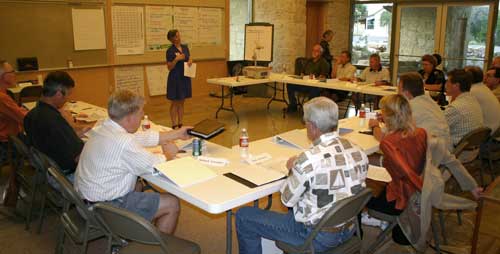 Gotta
hand it to facilitators Juli, Judy and Mary. They really
know how to manage a meeting. They get it to run on time
and make sure everybody has a say. I am impressed with their
skills (skills I've never had).
Gotta
hand it to facilitators Juli, Judy and Mary. They really
know how to manage a meeting. They get it to run on time
and make sure everybody has a say. I am impressed with their
skills (skills I've never had).